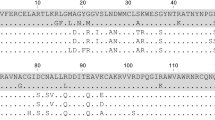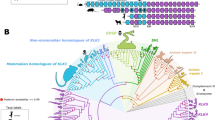Abstract
The blood feeding vampire bats emerged from New World leaf-nosed bats that fed on fruit and insects. Plasminogen activator, a serine protease that regulates blood coagulation, is known to be expressed in the saliva of Desmodus rotundus (common vampire bat) and is thought to be a key enzyme for the emergence of blood feeding in vampire bats. To better understand the evolution of this biological function, we studied the plasminogen activator (PA) genes from all vampire bat species in light of their feeding transition to bird and subsequently mammalian blood. We include the rare species Diphylla ecaudata and Diaemus youngi, where plasminogen activator had not previously been studied and demonstrate that PA gene duplication observed in Desmodus is not essential to the vampire phenotype, but relates to the emergence of predominant mammalian blood feeding in this species. Plasminogen activator has evolved through gene duplication, domain loss, and sequence evolution leading to change in fibrin-specificity and susceptibility to plasminogen activator inhibitor-1. Before undertaking this study, only the four plasminogen activator isoforms from Desmodus were known. The evolution of vampire bat plasminogen activators can now be linked phylogenetically to the transition in feeding behavior among vampire bat species from bird to mammalian blood.




Similar content being viewed by others
References
Basanova AV, Baskova IP, Zavalova LL (2002) Vascular-platelet and plasma hemostasis regulators from bloodsucking animals. Biochemistry-Moscow 67:143–150
Bennett WF, Paoni NF, Keyt BA, Botstein D, Jones AJ, Presta L, Wurm FM, Zoller MJ (1991) High resolution analysis of functional determinants on human tissue-type plasminogen activator. J Biol Chem 266:5191–5201
Bode W, Renatus M (1997) Tissue-type plasminogen activator: variants and crystal/solution structures demarcate structural determinants of function. Curr Opin Struct Biol 7:865–872
Carmeliet P, Schoonjans L, Kleckans L, Ream B, Degen J, Bronson R, De Vos R, van den Oord JJ, Collen D, Mulligan RC (1994) Physiological consequences of loss of plasminogen activator gene function in mice. Nature 368:419–424
Dellas C, Loskutoff DJ (2005) Historical analysis of PAI-1 from its discovery to its potential role in cell motility and disease. Thromb Haemost 93:631–640
Dong N, Da Cunha V, Citkowicz A, Wu F, Vincelette J, Larsen B, Wang YX, Ruan C, Dole WP, Morser J, Wu Q, Pan J (2004) P-selectin-targeting of the fibrin selective thrombolytic Desmodus rotundus salivary plasminogen activator alpha1. Thromb Haemost 92:956–965
Frank MB (1997) In: Frank MB (ed) Molecular biology protocols. (Oklahoma City, http://omrf.ouhsc.edu/~frank)
Gardell SJ, Duong LT, Diehl RE, York JD, Hare TR, Register RB, Jacobs JW, Dixon RA, Friedman PA (1989) Isolation, characterization, and cDNA cloning of a vampire bat salivary plasminogen activator. J Biol Chem 264:17947–17952
Greenhall AM, Schutt WA (1996) Diaemus youngi. Mamm Species 533:1–7
Greenhall AM, Joermann R, Schmidt U, Seidel M (1983) Desmodus rotundus. Mamm Species 202:1–6
Guindon S, Gascuel O (2003) A simple, fast, and accurate algorithm to estimate large phylogenies by maximum likelihood. Syst Biol 52:696–704
Hawkey C (1966) Plasminogen activator in saliva of the vampire bat Desmodus rotundus. Nature 211:434–435
Hoyt RA, Altenbach JS (1981) Observations on Diphylla ecaudata in captivity. J Mammol 62:215–216
Hughes T, Liberles DA (2007) The pattern of evolution of smaller scale gene duplicates in mammalian genomes is more consistent with neo- than sub-functionalisation. J Mol Evol 65:574–588
Kaneko M, Sakata Y, Matsuda Y, Mimuro J (1992) Interactions between the finger and kringle-2 domains of tissue-type plasminogen activator and plasminogen activator inhibitor-1. J Biochem 111:244–248
Katoh K, Kuma K, Toh H, Miyata T (2005) MAFFT version 5: improvement in accuracy of multiple sequence alignment. Nucleic Acids Res 33:511–518
Kratzschmar J, Haendler B, Langer G, Boidol W, Bringmann P, Alagon A, Donner P, Schleuning WD (1991) The plasminogen activator family from the salivary gland of the vampire bat Desmodus rotundus: cloning and expression. Gene 105:229–237
Liberatore GT, Samson A, Bladin CF, Schleuning WD, Medcalf RL (2003) Vampire bat salivary plasminogen activator (Desmoteplase). A unique fibrinolytic enzyme that does not promote neurodegeneration. Stroke 34:537–543
Liberles DA (2001) Evaluation of methods for determination of a reconstructed history of gene sequence evolution. Mol Biol Evol 18:2040–2047
Lynch M, Conery JS (2003) The evolutionary demography of duplicate genes. J Struct Func Genomics 3:35–44
Ohno S (1970) Evolution by gene duplication. Springer, New York
Pond SL, Frost SD, Muse SV (2005) HyPhy: hypothesis testing using phylogenies. Bioinformatics 21:676–679
Posada D, Buckley TR (2004) Model selection and model averaging in phylogenetics: advantages of akaike information criterion and bayesian approaches over likelihood ratio tests. Syst Biol 53:793–808
Posada D, Crandall KA (1998) MODELTEST: testing the model of DNA substitution. Bioinformatics 14:817–818
Renatus M, Stubbs MT, Huber R, Bringmann P, Donner P, Schleuning WD, Bode W (1997) Catalytic domain structure of vampire bat plasminogen activator: a molecular paradigm for proteolysis without activation cleavage. Biochemistry 36:13483–13493
Ronquist F, Huelsenbeck JP (2003) MrBayes 3: Bayesian phylogenetic inference under mixed models. Bioinformatics 19:1572–1574
Roth C, Rastogi S, Arvestad L, Dittmar K, Light S, Ekman D, Liberles DA (2007) Evolution after gene duplication: models, mechanisms, sequences, systems, and organisms. J Exp Zool 308B:58–73
Sazima I, Uieda W (1980) Feeding behavior of the white-winged vampire bat, Diaemus youngii, on poultry. J Mammol 61:102–104
Schleuning WD, Alagon A, Boidol W, Bringmann P, Petri T, Kratzshcmar J, Haendler B, Langer G, Baldus B, Witt W, Donner P (1992) Plasminogen activators from the saliva of Desmodus rotundus (Common Vampire Bat): unique fibrin specificity. Annals NY Acad Sci 667:395–403
Schutt WA, Altenbach JS, Chang YH, Cullinane DM, Hermanson JW, Muradali F, Bertram JEA (1997) The dynamics of flight-initiating jumps in the common vampire bat Desmodus rotundus. J Exp Biol 200:3003–3012
Stewart RJ, Fredenburgh JC, Weitz JI (1998) Characterization of the interactions of plasminogen and tissue and vampire bat plasminogen activators with fibrinogen, fibrin, and the complex of D-dimer noncovalently linked to fragment E. J Biol Chem 273:18292–18299
Thelwell C, Longstaff C (2007) The regulation by fibrinogen and fibrin of tissue plasminogen activator kinetics and inhibition by plasminogen activator inhibitor 1. J Thromb Haemost 5:804–811
Trajano E (1996) Movements of cave bats in southeastern Brazil, with emphasis on the population ecology of the common vampire bats, Desmodus rotundus (Chiroptera). Biotropica 18:121–129
Wetterer JK, Rockman MV, Simmons NB (2000) Phylogeny of phyllostomid bats (Mammalia: Chiroptera): data from diverse morphological systems, sex chromosomes, and restriction sites. Bull Am Mus Nat Hist 248:1–200
Yang Z (1998) Likelihood ratio tests for detecting positive selection and application to primate lysozyme evolution. Mol Biol Evol 15:568–573
Yang Z (2007) PAML 4: phylogenetic analysis by maximum likelihood. Mol Biol Evol 24:1586–1591
Yang Z, Wong WSW, Nielsen R (2005) Bayes empirical Bayes inference of amino acid sites under positive selection. Mol Biol Evol 22:1107–1118
Zhang J, Nielsen R, Yang Z (2005) Evaluation of an improved branch-site likelihood method for detecting positive selection at the molecular level. Mol Biol Evol 22:2472–2479
Acknowledgments
We thank Don Jarvis and Christoph Geisler for materials, equipment, and technical assistance. Samples of Carollia perspicillata, Diphylla ecaudata, Desmodus rotundus, and Diaemus youngi were provided by: Uwe Schmidt at University of Bonn, Germany, The Field Museum (Bruce Patterson), Daniel Abrams at Rancho Transylvania, New Mexico, K. Harada at Osaka City University, and Texas Tech University Museum in addition to samples collected by the authors of this paper. Funding for this work has been provided by an INBRE (NIH) grant to University of Wyoming, the Carl Trygger Foundation, and FUGE. The experiments performed comply with the current laws of the United States, Norway, and Sweden, where this research was performed. Sequences were submitted to Genbank, with Carollia sequences under accession bankit1121506, Diphylla sequences under accession bankit1121509, and Diaemus sequences under accession bankit1121511.
Author information
Authors and Affiliations
Corresponding author
Electronic supplementary material
Below is the link to the electronic supplementary material.
Supplmentary Figure 1 (S1)
Phylogenetic tree including alleles (DOC 55.0 KB)
Supplementary Figure 2 (S2)
Alignment with alleles (DOC 52.5 KB)
Rights and permissions
About this article
Cite this article
Tellgren-Roth, Å., Dittmar, K., Massey, S.E. et al. Keeping the blood flowing—plasminogen activator genes and feeding behavior in vampire bats. Naturwissenschaften 96, 39–47 (2009). https://doi.org/10.1007/s00114-008-0446-0
Received:
Revised:
Accepted:
Published:
Issue Date:
DOI: https://doi.org/10.1007/s00114-008-0446-0




